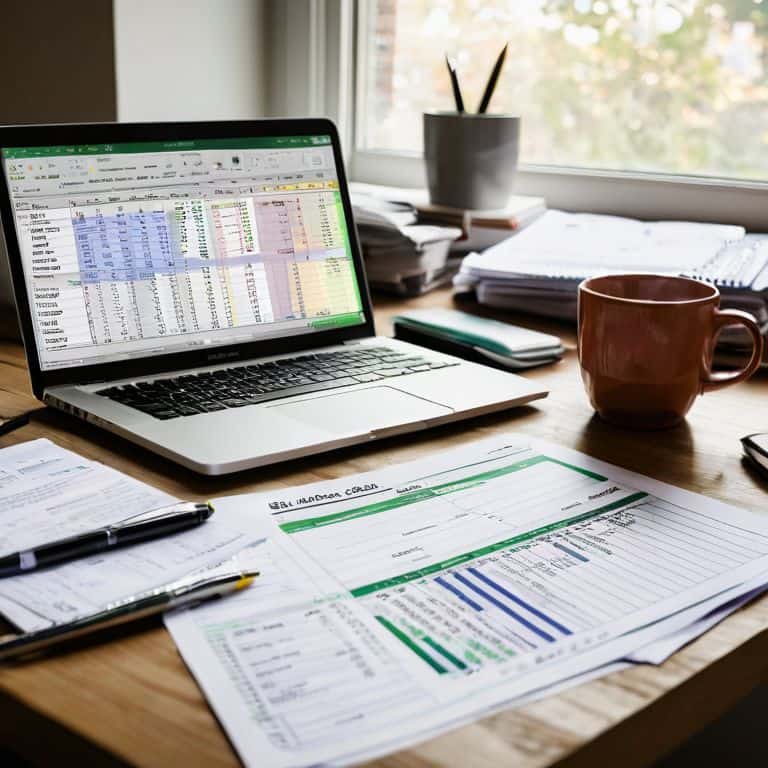I still remember the feeling of being overwhelmed by debt, like I was carrying a heavy backpack on a long hike with no end in sight. But I learned that how to pay off debt isn’t just about throwing money at the problem, it’s about creating a clear plan and sticking to it. The common myth that you need to make drastic changes to your lifestyle in order to pay off debt is not only frustrating, but it’s also not entirely true. In reality, it’s often the small, consistent changes that add up to make a big difference.
As you read this article, I want you to know that you’re not alone in this struggle. You’ll learn practical strategies for tackling debt, from creating a budget that actually works for you, to automating your payments so you can focus on what really matters. My goal is to provide you with a clear, step-by-step guide on how to pay off debt and find financial peace of mind. By the end of this article, you’ll have a better understanding of how to take control of your finances and start building a more secure future.
Table of Contents
Guide Overview: What You'll Need

Total Time: several months to several years
Estimated Cost: varies depending on debt amount
Difficulty Level: Intermediate / Hard
Tools Required
- Budgeting Spreadsheet (available online or through accounting software)
- Calculator (for calculating interest rates and payments)
Supplies & Materials
- Pen and Paper (for tracking expenses and creating a budget)
- Debt Repayment Plan Template (available online or through financial counseling services)
Step-by-Step Instructions
- 1. First, let’s get real about your debt situation – take a deep breath, gather all your financial documents, and make a list of all your debts, including credit cards, loans, and any other outstanding balances. Write down the balance, interest rate, and minimum payment for each debt, so you can see the big picture and understand what you’re up against.
- 2. Next, it’s time to face the music and track your expenses to see where your money is going – for one month, write down every single transaction, no matter how small, in a notebook or use an app to make it easier. This will help you identify areas where you can cut back on unnecessary spending and free up more money to put towards your debt.
- 3. Now, let’s talk about creating a budget that actually works for you – based on your income and expenses, allocate your money into categories, such as housing, food, transportation, and debt repayment. Make sure to prioritize your needs over your wants, and be honest with yourself about what you can really afford.
- 4. With your budget in place, it’s time to tackle your debt – decide which debt to pay off first, either by focusing on the one with the highest interest rate or the smallest balance. Use the snowball method or the avalanche method, whichever one works best for your situation, and make a plan to pay more than the minimum payment each month.
- 5. To stay on track, set up automatic payments for your debts, so you can ensure that you never miss a payment. Use the 50/30/20 rule as a guideline to allocate your income towards necessary expenses, discretionary spending, and saving and debt repayment.
- 6. As you’re paying off your debt, remember to be kind to yourself – it’s a process that takes time, and it’s okay to make mistakes along the way. Celebrate your small wins, like paying off a credit card or reaching a milestone, to keep yourself motivated and encouraged to keep moving forward.
- 7. Finally, let’s talk about maintaining the momentum – once you’ve paid off your debt, use the money you were paying towards debt to build an emergency fund or invest in your future. This will help you avoid going back into debt and create a safety net for unexpected expenses.
How to Pay Off Debt

As you embark on your debt repayment journey, it’s essential to consider debt management plans that work for you. This might involve creating a budget that allocates a significant portion of your income towards debt repayment. Remember, budgeting for debt repayment is not about depriving yourself, but about making conscious choices that align with your financial goals. By prioritizing your debts and making regular payments, you’ll be taking a significant step towards financial freedom.
When it comes to debt repayment strategies, there are two popular methods: the snowball method and the avalanche method. The snowball method involves paying off debts with the smallest balances first, while the avalanche method focuses on debts with the highest interest rates. Both methods have their advantages, and it’s crucial to choose the one that works best for your situation. You may also want to consider negotiating with creditors to reduce interest rates or waive fees.
To make the most of your debt repayment efforts, it’s essential to understand the credit score impact on debt. By maintaining a good credit score, you’ll have access to better interest rates and more favorable loan terms. Consider exploring debt consolidation loans for bad credit as an option, but be sure to carefully review the terms and conditions before making a decision. By taking a mindful and informed approach to debt repayment, you’ll be well on your way to achieving financial peace of mind.
Breathe Easy Debt Management Plans
As we dive into debt management plans, remember that it’s essential to be kind to yourself throughout this process. You’ve taken the first step by acknowledging your debt, and that’s something to be proud of. Now, let’s work on creating a plan that works for you, not against you. I recommend starting with a debt inventory, where you list all your debts, including balances, interest rates, and minimum payments. This will give you a clear picture of what you’re dealing with.
By prioritizing your debts, you can focus on tackling the most critical ones first. Consider the snowball method, where you pay off smaller debts quickly to build momentum, or the avalanche method, which targets high-interest debts first. Remember, there’s no one-size-fits-all approach, so it’s crucial to find a method that resonates with you and your financial goals.
Snowball vs Avalanche Finding Your Fit
When it comes to tackling debt, two popular methods come to mind: the snowball and avalanche approaches. The snowball method, popularized by Dave Ramsey, involves paying off debts with the smallest balances first, while making minimum payments on larger debts. This approach can provide a psychological boost as you quickly eliminate smaller debts. On the other hand, the avalanche method focuses on paying off debts with the highest interest rates first, which can save you more money in interest over time.
I recommend considering your personality and financial situation when choosing between these methods. If you need a morale boost, the snowball method might be the way to go. However, if you’re more interested in saving money on interest, the avalanche approach could be a better fit.
5 Mindful Steps to Debt Freedom
- Face Your Finances: Take a deep breath and gather all your financial documents to get a clear picture of your debt landscape
- Automate Your Payments: Set up automatic transfers to make timely payments and reduce stress
- Prioritize Needs Over Wants: Distinguish between essential expenses and discretionary spending to allocate your resources wisely
- Negotiate with Creditors: Don’t be afraid to reach out to your creditors to discuss possible interest rate reductions or temporary payment suspensions
- Celebrate Small Wins: Acknowledge and celebrate each debt milestone you achieve to stay motivated and encouraged throughout your debt repayment journey
Mindful Money Takeaways
By automating your finances and creating a personalized debt repayment plan, you can break free from the stress of debt and focus on what truly matters to you
Remember, there’s no one-size-fits-all approach to paying off debt – whether you choose the snowball or avalanche method, the key is to find a rhythm that works for you and stick to it
Ultimately, paying off debt is not just about the numbers – it’s about cultivating a healthier relationship with money and freeing yourself from the emotional weight of debt, so you can live a more intentional, peaceful life
A Mindful Approach to Debt
Paying off debt isn’t just about freeing yourself from financial burdens, it’s about reclaiming your sense of self and aligning your spending with what truly adds value to your life.
Leo Carter
Breaking Free from Debt: A Path to Financial Peace

As we’ve journeyed through this guide on how to pay off debt, we’ve covered the essential steps to help you regain control of your finances. From creating a debt management plan to choosing between the snowball and avalanche methods, it’s clear that paying off debt is not just about the numbers, but about finding a sustainable rhythm that works for you. By automating your payments, reducing expenses, and increasing income, you’ll be well on your way to breaking free from the weight of debt. Remember, it’s a process that takes time, patience, and self-compassion, but the end result is well worth the effort.
As you close this chapter and embark on your debt-free journey, I want to leave you with a final thought: financial freedom is not just about the money; it’s about the peace of mind that comes with it. It’s about being able to pursue your passions, spend time with loved ones, and live a life that truly reflects your values. So, take a deep breath, stay committed to your plan, and trust that with each passing day, you’re one step closer to a brighter, more financially fulfilling future.
Frequently Asked Questions
What are the best strategies for negotiating with creditors to reduce debt?
Negotiating with creditors can be intimidating, but it’s a powerful step towards debt freedom. I recommend starting with a clear understanding of your financial situation and a specific proposal in mind. Be honest, respectful, and open to compromise – you might be surprised at the willingness to work with you.
How can I balance paying off high-interest debt with building an emergency fund?
To balance paying off high-interest debt with building an emergency fund, I recommend allocating a portion of your income to each goal. Start by putting a small amount, say 1-2 months’ worth of expenses, into a savings account, while also making regular debt payments. As your emergency fund grows, you can adjust the ratio to focus more on debt repayment.
Are there any tax implications or benefits to consider when paying off debt, such as debt forgiveness programs?
When paying off debt, it’s essential to consider tax implications. For instance, debt forgiveness programs may be taxable as income. However, programs like the Mortgage Forgiveness Debt Relief Act can provide tax relief. It’s crucial to consult a tax professional to understand the specifics and make informed decisions that won’t add to your financial burden.
